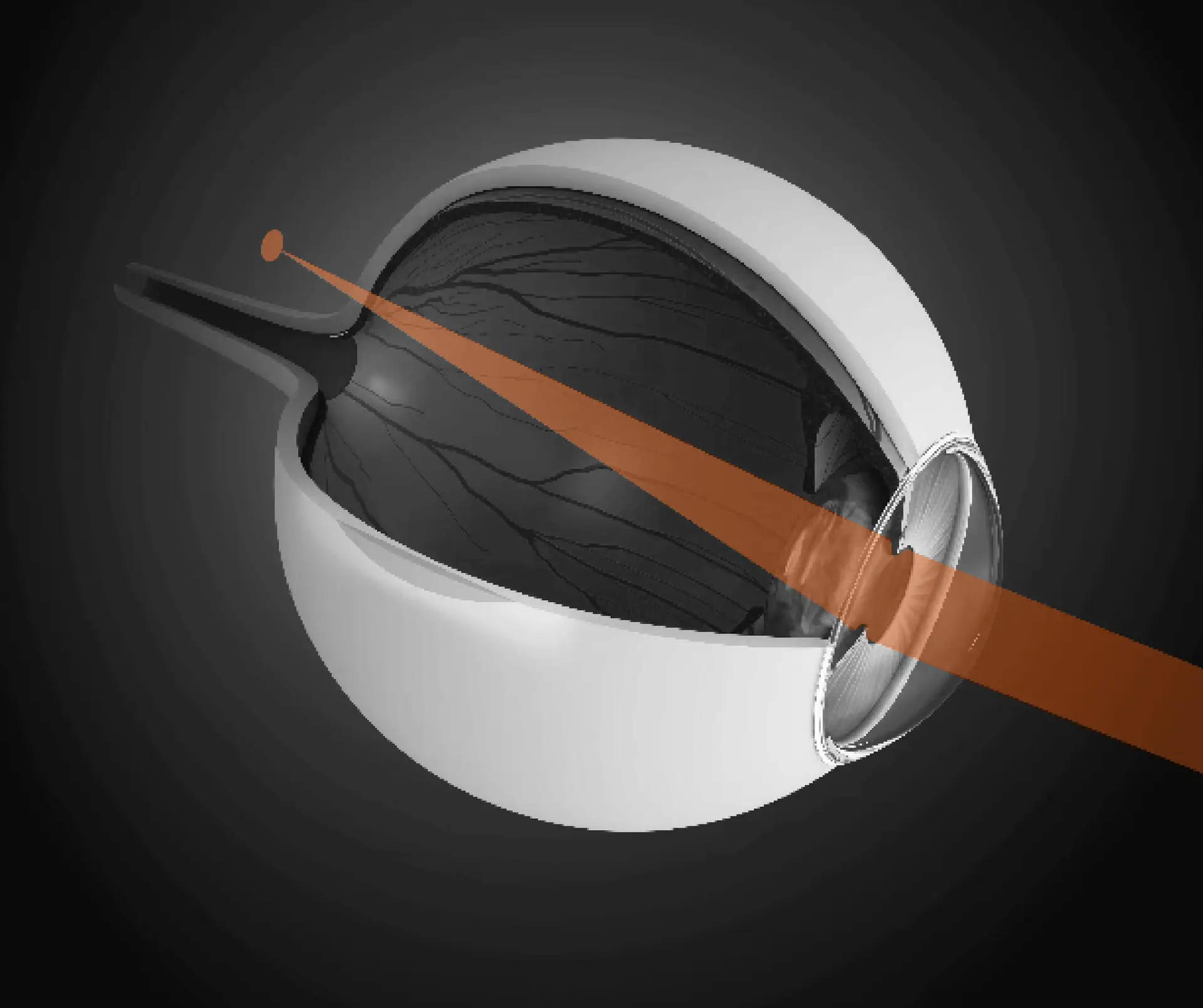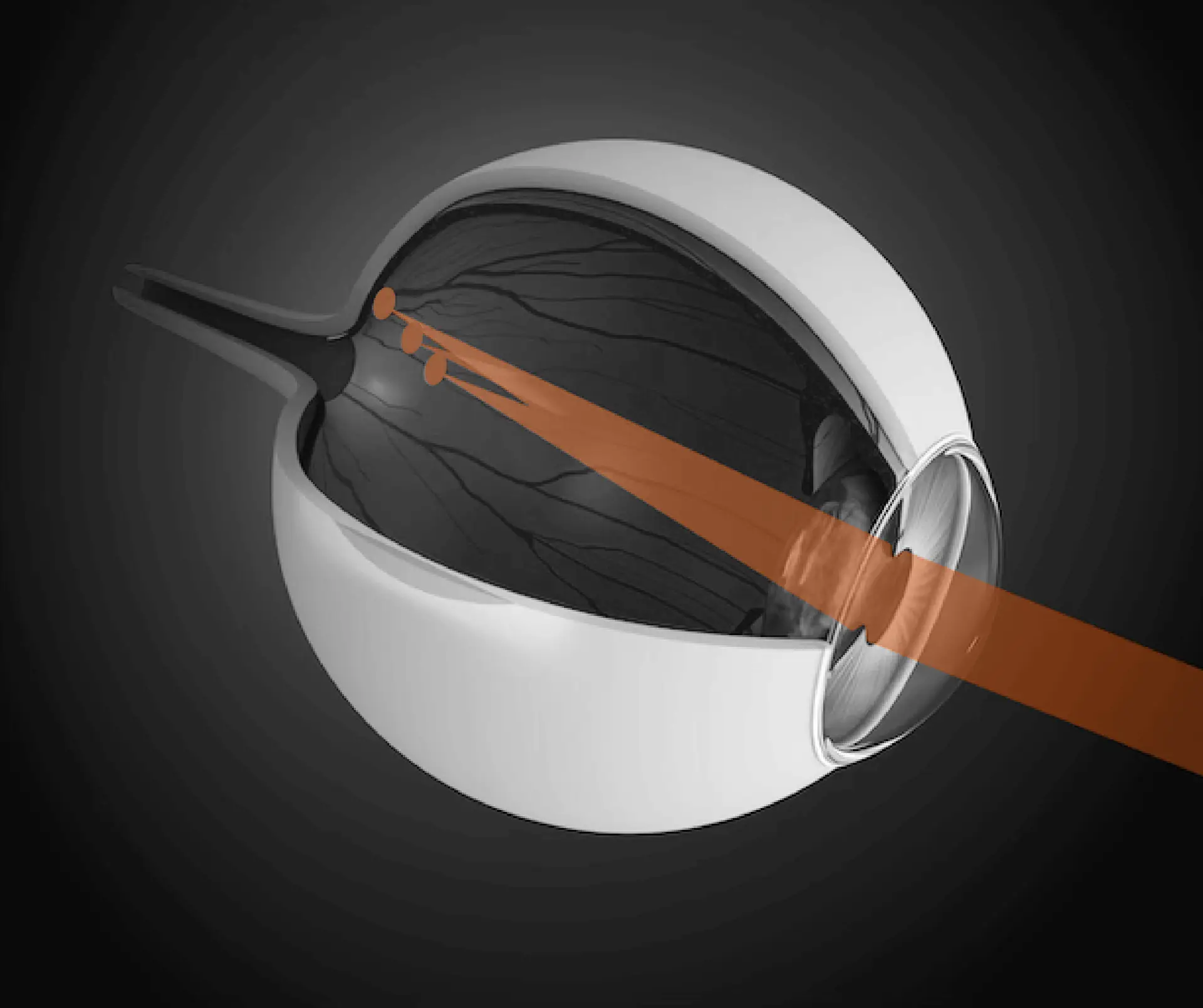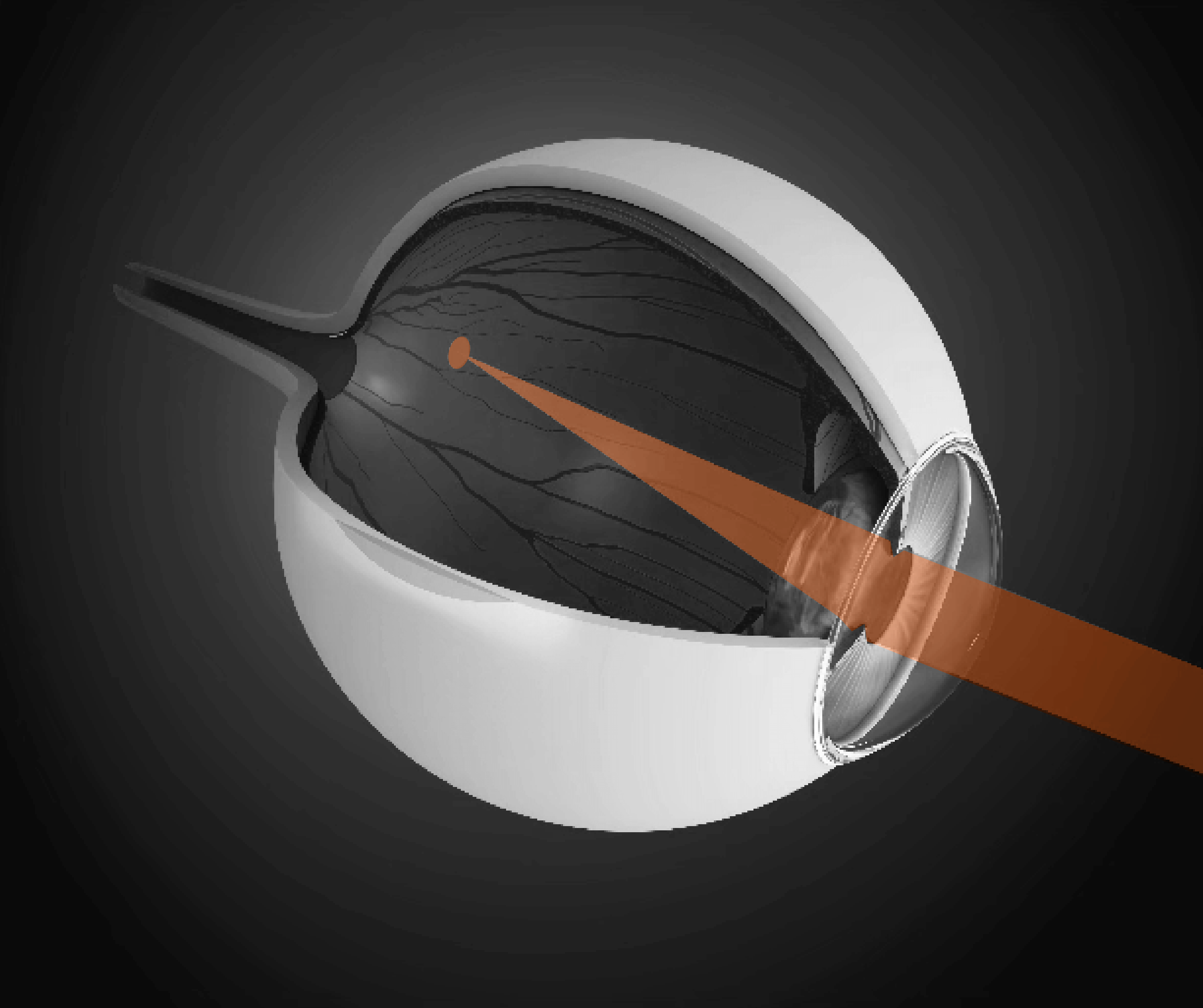If LASIK isn’t the right fit for you, PRK (Photorefractive Keratectomy) offers an excellent alternative to help you achieve clear, unaided vision. PRK is a highly effective laser vision correction procedure designed to reshape the cornea and improve how light is focused—reducing or eliminating the need for glasses or contact lenses.
PRK is particularly beneficial for patients with thin corneas, as it does not require the creation of a corneal flap like LASIK. Instead, the outer layer of the cornea (epithelium) is gently removed, allowing the laser to reshape the underlying tissue with extreme precision. PRK is often recommended for those involved in contact sports. Although long term results are similar to LASIK recovery takes longer.
Conditions PRK Can Correct

Myopia (Nearsightedness)
Difficulty seeing distant objects

Hyperopia (Farsightedness)
Difficulty seeing close objects

Astigmatism
Blurry vision due to an irregularly shaped cornea

Presbyopia (Age-related vision changes)
PRK can be modified to include PresbyPRK, an option for those over 40 experiencing age-related near vision loss
How PRK Works | Step by Step

1. Cornea is Measured & Mapped
- Your ophthalmologist will measure corneal thickness and take a detailed scan of its surface.
- These measurements program the computer-controlled laser for precise reshaping.

2. Anaesthetic drops
- Anaesthetic drops are applied to numb the eye and prevent discomfort.
- A gentle eyelid holder prevents blinking during the procedure.

3. Laser Reshapes the Cornea
- You will be asked to focus on a light to keep your eye steady.
- A high-precision excimer laser reshapes the cornea using mathematical algorithms.
- The laser removes microscopic amounts of tissue to correct your vision with extreme accuracy.

4. Bandage Contact Lens for Healing
- A special bandage contact lens is placed over your cornea to protect it and aid healing.
- You will receive antibiotic and anti-inflammatory eye drops to prevent infection and promote recovery.
Vision After PRK
- Day 1-3: You may experience some discomfort, light sensitivity, and fluctuating vision.
- Day 3-5: The bandage contact lens is typically removed once the epithelium has healed.
- Week 1: Most patients are able to resume daily activities, but vision may still be adjusting.
- 4-6 Weeks: Vision stabilizes and continues to improve.
- 3-6 Months: Final visual outcomes are achieved.
PRK vs. LASIK: Key Differences
Feature
| PRK
| LASIK
Corneal Flap
No
Yes
Recovery Time
Slower (Weeks)
Faster (days)
Post-Surgery Discomfort
More (first few days)
Less
Suitable for Thin Corneas?
Yes
No
Final Visual Outcome
Same as LASIK
Same as PRK
Your surgeon will determine the best procedure for your unique eyes during your consultation.
Who is an Ideal Candidate for PRK?
To qualify for PRK, you should:
- Be 18 to about 55 years
- Have thin corneas or irregular corneal surfaces, making LASIK unsuitable
- Be in good overall health and have no active eye diseases
- Want to reduce or eliminate your dependence on glasses or contact lenses
- Have a script of -6 to +2 with astigmatism of less than 4
Not sure if Laser Vision Correction is right for you? Take our free online self-test or book a consultation.
What if I Am Not a PRK Candidate?
If PRK isn’t right for you, there are alternative refractive procedures available:
Your ophthalmologist will recommend the best option based on your eye health and vision goals.
Cost & Payment Options
What’s Included?
- Pre-surgery assessment & scans
- PRK procedure
- Complimentary follow-ups for 6 weeks
- Post-op care and guidance
- Financing Options Available
Why Choose Sandton Eye Clinic for LASIK?
- Expert Refractive Surgeons: Internationally qualified and experienced refractive surgeons dedicated to patient care.
- State-of-the-Art Laser Technology: For maximum precision and safety.
- Comprehensive Screening: Thorough pre-operative assessment to ensure the best outcomes
- High Patient Satisfaction: Thousands of successful procedures and life-changing results.
PRK FAQs
Everything you need to know about PRK and laser vision correction.
PRK & LONGEVITY
How long does PRK last? Will my eyesight deteriorate again later in life?
PRK is a permanent procedure that reshapes the cornea to correct vision. It does not wear off over time, and most patients enjoy long-term clear vision.
However, as part of the natural aging process, vision changes may still occur:
- Around age 45, presbyopia (the need for reading glasses) develops, affecting everyone, whether they had PRK or not. If reading glasses become necessary, PresbyPRK can help restore near vision.
- By age 60-65, many people develop cataracts, affecting vision clarity. At this stage, cataract surgery with premium multifocal lenses can restore both near and distance vision.
I had PRK years ago. Can I get the procedure again?
Yes, PRK enhancement can often be performed if your vision has changed, provided your cornea is thick enough.
For patients over 40, near vision changes are usually due to presbyopia, meaning blended vision treatments may be a better solution than repeating PRK.
What are the best vision correction options for different age groups?
- Ages 18 to 40 – LASIK, PRK or implantable contact lenses for nearsightedness, farsightedness, and astigmatism.
- Ages 40 to 55 - PresbyLASIK, Allotex Allograft Inlay or implantable contact lenses to reduce dependence on reading glasses.
- Ages 55+ - Cataract surgery or custom lens replacement with multifocal intraocular lenses (IOLs) for long-term spectacle independence.
SAFETY & RISKS
How Do You Choose a Refractive Surgeon?
Selecting the right Refractive surgeon is one of the most important steps in your vision correction journey. Just as luxury watchmaking requires a combination of precision, expertise, and craftsmanship, refractive surgery demands skill, experience, and meticulous attention to detail.
A true refractive surgeon does more than perform a procedure—they enhance lives by helping patients achieve clear, unaided vision. Their expertise is not a luxury but a necessity.
Key Factors to Consider When Choosing a Refractive Surgeon:
- Experience & Training – Look for a surgeon with specialized training in refractive surgery and extensive experience performing thousands of LASIK procedures.
- Technology & Techniques – Ensure they use advanced laser systems for precision and safety.
- Success Record – Ask about their visual outcome statistics and patient satisfaction rates.
- Patient Reviews & Testimonials – Read about real patient experiences to gain insight into their care and results.
- Personalized Approach – A great surgeon takes the time to evaluate your unique vision needs and discuss the best options for you.
Read more about Dr. Lourens Coetzee here.
Speak to a vision correction consultant: 011 784 7000 Does PRK hurt?
Your eyes will be numbed with aesthetic drops during the procedure, so you won’t feel pain.
Post-surgery, discomfort, scratchiness, mild swelling and light sensitivity may last a few days to a week but is manageable with medication and a cold compresses. You will also receive a mild sedating tablet to calm your nerves during the procedure.
Is PRK as Safe as LASIK—and How Does It Compare to Contact Lenses?
Glasses remain the safest option for vision correction, as they do not involve any medical procedure. However, if you already wear contact lenses, you’re likely prioritising visual freedom—and considering laser surgery is a natural next step.
PRK vs. LASIK
Both PRK and LASIK are highly safe and effective procedures when performed by an experienced refractive surgeon. PRK is often recommended for patients with thin or irregular corneas, and for individuals who engage in contact sports or activities where eye trauma risk is higher—since PRK does not involve creating a corneal flap.
Laser Vision Correction vs. Long-Term Contact Lens Use
A major long-term study involving 1,800 patients over 3 years compared LASIK with continued contact lens use. Results showed:
- Better Night Vision – Patients who had LASIK reported fewer night vision symptoms such as glare and halos while driving at night compared to contact lens users.
- Less Dry Eye Discomfort – While temporary dryness can occur after LASIK, long-term contact lens users had a higher prevalence of chronic dry eye symptoms.
- Lower Risk of Infection – The risk of a sight-threatening corneal infection is 10 times higher in long-term contact lens users compared to LASIK patients.
- Higher Satisfaction Rates – 99% of patients who underwent LASIK agreed that it worked better for them than contact lenses in terms of convenience, comfort, and vision quality.
While every vision correction method has risks, PRK and LASIK are controlled, one-time medical procedures with an excellent safety record. In contrast, contact lenses require daily maintenance and carry a cumulative risk of complications over time.
If you’re ready for a lifestyle with fewer visual limitations, PRK may be the safer long-term solution compared to years of contact lens wear.
PROCEDURE & CANDIDACY
What vision problems can PRK correct?
- Myopia (Nearsightedness) – Blurred distance vision.
- Hyperopia (Farsightedness) – Blurred near vision.
- Astigmatism – Distorted vision at all distances.
- Presbyopia – Age-related near vision loss (treated with PresbyLASIK).
What if I am not a candidate for PRK?
Alternative options for 18- 40 years of age include:
Alternative options for 40- 55 years of age include:
Alternative options for 55 and older include:
Is PRK reversed during pregnancy?
Pregnancy does not cause permanent changes to your cornea, and it does not reverse PRK. Hormones during pregnancy causes temporary changes in the cornea which may influence your vision whether you had PRK or not.
A few months after delivering you baby your vision should return to normal. You can have PRK before you get pregnant and a few months after pregnancy and breastfeeding but not during pregnancy.
Can I Have PRK on One Eye?
In most cases, both eyes require correction and are treated during the same session to ensure balanced vision and faster recovery.
However, there are specific situations where single-eye PRK may be the best or only option:
- Perfect Vision in One Eye – If one eye has no refractive error, there's no need for treatment.
- Different Eye Conditions - If the other eye has a condition that PRK cannot correct, such as advanced retinal disease, previous trauma, or if it is non-seeing (blind).
- Presbyopia Correction Only – If your distance vision is normal and you're only seeking near vision improvement, it’s sometimes beneficial to perform PRK on just the non-dominant eye to reduce dependence on reading glasses (a technique called monovision or blended vision).
- Staged Treatments – In rare cases, your surgeon may recommend treating one eye first to observe healing or visual adaptation before proceeding with the second eye.
📌 Your ophthalmologist will guide this decision based on your lifestyle, prescription, and long-term vision goals. Each eye is unique—and so is your treatment plan.
Will I be awake during my PRK procedure?
Yes, but your eyes will be numbed, and you won’t feel pain during the 20 minute procedure. A mild sedative can be provided to help you relax.
What laser technology does Sandton Eye Clinic use?
At Sandton Eye Clinic, we use the latest advanced laser technology to ensure precision, safety, and optimal visual outcomes. Our LASIK procedure involves two state-of-the-art lasers:
✔ Femtosecond Laser – Ziemer Z6: Used to create a precise, ultra-thin corneal flap with minimal disruption to surrounding tissue, enhancing safety and recovery.
✔ Excimer Laser – Schwind Amaris 1050: A 7D eye-tracking laser system that reshapes the cornea.
- Extreme precision for highly customized vision correction.
- Fast laser pulse rates, ensuring a smooth, comfortable treatment.
- 7D tracking system that compensates for even the smallest eye movements, minimizing the risk of over- or under-correction.
When Is the Best Time to Get PRK?
The best time to get PRK is when you’re ready to enjoy life with fewer visual limitations—and the sooner, the better. By having PRK earlier in life, you maximise the number of years you can enjoy clear, unaided vision without the daily hassle of glasses or contact lenses.
Younger eyes also tend to heal more quickly and respond more predictably, contributing to smoother recovery and long-lasting results.
Ideal Timing for PRK:
- 18+ years – You can qualify for PRK from age 18. Early treatment means more years of enjoying clear vision and an active lifestyle—without the limits of corrective eyewear.
- Around 45 years – As presbyopia begins to affect near vision, PRK becomes an excellent solution. It’s designed to restore both near and distance vision, reducing the need for reading glasses.
📌 Whether you’re starting your adult life or entering a new chapter in your 40s, PRK offers customised options to match your vision needs and goals.
When to Consider PRK?
If you’re happy wearing glasses, PRK may not be necessary. But many people reach a turning point when they realise that glasses or contact lenses no longer fit their lifestyle or vision goals.
You might be ready for PRK if you’ve experienced any of the following:
✔ Losing or breaking your glasses—again
✔ Dealing with dry, uncomfortable, or infected contact lenses
✔ Planning an adventure holiday or outdoor activity where glasses are impractical
✔ Playing contact sports where eyewear is a hassle and LASIK may not be suitable due to the risk of flap displacement
Whether you’re seeking freedom, looking to simplify your routine, or want to see clearly without barriers, PRK can offer a lasting lifestyle upgrade.
COST & FINANCING
Will my medical aid cover PRK?
Most medical aids do not cover PRK or other Laser Vision Correction procedures, as it’s considered an elective procedure.
Some plans may cover pre-surgery tests from your day-to-day benefits.
Do you offer payment plans for PRK?
Yes! We offer financing through MediWallet:
✔ Get pre-approved – Send your ID & 3 months’ bank statements.
✔ First 3 months interest-free.
✔ Flexible repayment terms.
📌 Visit www.mediwallet.co.za for details.
POST-PROCEDURE & RECOVERY
How long does recovery take?
- Day 1-3: You may experience some discomfort, light sensitivity, and fluctuating vision.
- Day 3-5: The bandage contact lens is typically removed once the epithelium has healed.
- Week 1: Most patients are able to resume daily activities and return to work, but vision may still be adjusting.
- 4-6 Weeks: Vision stabilizes and continues to improve.
- 3-6 Months: Final visual outcomes are achieved.
- Avoid swimming and high-impact activities for 4 weeks.
When can I wear makeup again?
- Face makeup: After 24 hours.
- Eye makeup (mascara, eyeliner, eyeshadow): Wait 2 weeks to avoid infections.
Can I fly after PRK?
Yes, but use lubricating eye drops to prevent dryness on flights.
LOGISTICS & APPOINTMENTS
Do I need a driver after my consultation?
Yes, as your eyes will be dilated, causing temporary blurry vision and light sensitivity.
Can I have PRK on the same day as my consultation?
No, as procedure planning requires additional scans and tests before scheduling surgery.
Do I need follow-up appointments?
Yes! Follow-ups are essential to:
✔ Ensure proper healing.
✔ Detect and treat side effects early.
✔ Adjust treatment if needed.
Still have questions?
We’re here to guide you toward clearer vision and a life free from glasses.
Take the first step toward clear vision – Schedule your consultation now!









